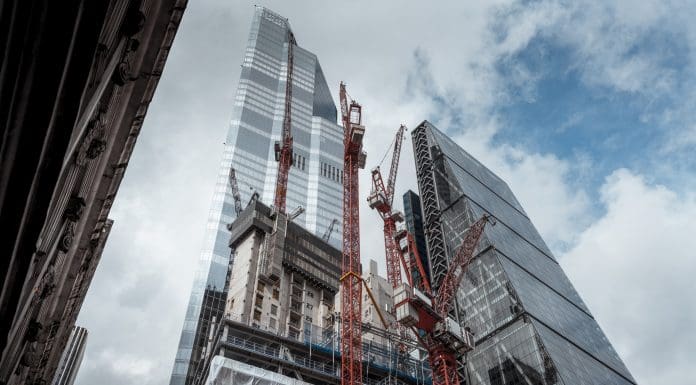
The July 2025 S&P Global UK Construction PMI reveals a steep decline in construction activity, with future outlooks growing increasingly pessimistic
The report reveals that a downturn in construction activity intensifies as firms see a renewed decline in housing projects while staff levels fall again despite rapidly rising subcontractor rates.
The quarter has seen the most rapid decline in industry activity since May 2020.
All three subsectors were hit with declining figures
The headline PMI dropped to 44.3 in July, down from 48.8 in June—a minor improvement from 47.9 in May—marking a sharp and significant downturn.
Demand has also remained an issue, with a decline in new incoming work for the seventh month running in July. This contraction is the largest since February and is coupled with a fall in tender opportunities.
The three monitored subsectors all experienced an individual decline as well, with civil engineering being hit the worst, followed by residential building and commercial construction.
A survey sent to construction firms revealed that site delays, decreased volumes of new business, and a weakening of customer confidence are to blame for the decrease in output.
Read the full July 2025 PMIs here.
Industry reacts to the July 2025 PMI
Read the comments below from members of the industry reacting to the latest figures.
Joe Hayes, principal economist at S&P Global Market Intelligence
“Having trended upwards in recent months, our survey data for July signal a fresh setback for the UK construction sector, with total industry activity falling at the sharpest rate since May 2020. Dissecting the latest contraction, we can see a fresh and sharp drop in residential building, as well as an accelerated fall in work carried out on civil engineering projects.
“Forward-looking indicators from the survey imply that UK constructors are preparing for challenging times ahead. They’re buying less materials and reducing the number of workers on the payroll. Expectations also continue to underwhelm, despite a modest pick-up in confidence from June’s two-and-a-half-year low.
“Anecdotally, companies reported a lack of tender opportunities and a hesitancy from customers to commit to projects. Broader themes of uncertainty, both domestically but also internationally, will do little to reignite investment appetites.”
Max Jones, director of infrastructure and construction at Lloyds
“Despite a challenging month, signs of recovery are emerging across the UK construction sector. Easing inflation has likely helped to stabilise core material costs including steel, concrete and aggregates. This has also potentially helped to operate supply chains more smoothly, improve project delivery and protect margins.
“However, with increased investment, progress on planning reform, and plans to expand their project pipelines, firms are likely to feel encouraged that more positive months are ahead.”
Gareth Belsham, director of Bloom Building Consultancy, commented:
“There’s no sugarcoating it – this data will be tough to swallow for almost everyone in construction. All three subsectors of the industry saw output contract in July, with the sharpest fall coming in civil engineering. Housebuilding, the sector beloved of politicians in need of a photo opp, also declined badly.
“To make matters worse, the pipeline of new work is drying up fast. New order numbers have now fallen for seven months in a row, with July’s slump the worst seen since February. Little wonder contractor confidence is weak and many construction firms are laying off payrolled staff.
“June saw sentiment plunge to its lowest level since December 2022, and while July’s figure improved marginally, even the most optimistic of builders will find it hard to see the glass as half full.
“Tomorrow the Bank of England is widely expected to cut its base rate for the third time this year, and the prospect of cheaper finance will be welcomed by developers who are struggling to square their finance costs with weak demand for their end product.
“The one bright spot is commercial sector construction. While it too saw output fall in July, at least more commercial schemes are being greenlit. Those that do are laser-focused on value and have a fully costed business case – there is minimal margin for error.”
Lynsay Turnbull, technical director at Thomas & Adamson, part of Egis Group
“It would appear that many of the challenges facing the construction sector have come to a head this month, with PMI figures showing the steepest decline since the height of the pandemic. Ongoing geopolitical and macroeconomic uncertainty continues to weigh heavily, causing project delays and dampening demand and tender activity. That said, we are also in the midst of the summer holiday period, a time when a natural slowdown is to be expected.
“Levels of optimism and confidence among those surveyed have also dipped, which is understandable given the data. However, the end of the summer often brings renewed momentum as teams refocus and drive towards year-end goals. Notably, commercial construction has experienced the softest decline this month, while the residential sector is still awaiting signs of recovery, despite the government’s renewed emphasis to housebuilding.
“While it may take time for these challenges to dissipate and provide momentum to the sector, collaboration and clear communication are essential in the meantime to try and reignite the potential pipeline of future work across each area of construction.”
The post Sharpest drop in construction activity in half a decade appeared first on Planning, Building & Construction Today.

